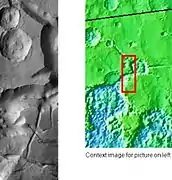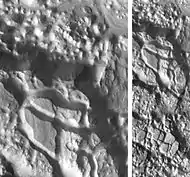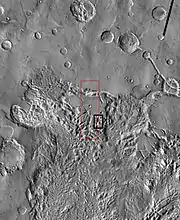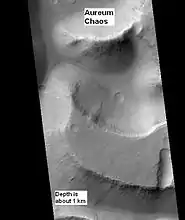Aureum Chaos
Aureum Chaos is a rough, collapsed region (chaos terrain) in the Margaritifer Sinus quadrangle (MC-19) portion of the planet Mars at approximately 4.4° south latitude and 27° west longitude, it is also in the west of Margaritifer Terra. It is 368 km across and was named after a classical albedo feature name.[1]
 Map showing location of Aureum Chaos (shown on the far left) along with Arsinoes Chaos (far left), Iani Chaos, Margaritifer Chaos, and other nearby features | |
| Coordinates | 4.4°S 27°W |
|---|---|
| Length | 368 km |
| Discoverer | Mariner 9 |
The classic name came from one of the first maps of Mars drawn by Schiaparelli who has been called the "Father of Mars." He called a feature "Aurea Cherso, which translates to the golden peninsula—an ancient name for Malaya.[2] Aureum is the Latin word for gold. In chemistry, the symbol for gold is Au from gold's Latin name.
In many places, the canyons of Aureum Chaos are about 1 km deep—a little more than half the depth of the Grand Canyon. But, Aureum Chaos covers an area about the size of the state of Alabama, almost 20 times larger than the Grand Canyon National Park.
Description
Aureum Chaos is a major canyon system and collapsed area. Large outflow channels on Mars are believed to be caused by catastrophic discharges of ground water.[3] Many of the channels begin in chaotic terrain, where the ground has apparently collapsed. In the collapsed section, blocks of undisturbed material can be seen. The OMEGA experiment on Mars Express discovered clay minerals (phyllosilicates) in a variety places in Aureum Chaos. Clay minerals need water to form, so the area may once have contained large amounts of water.[4] Scientists are interested in determining what parts of Mars contained water because evidence of past or present life may be found there. Aureum Chaos is one more piece of evidence that Mars once had great amounts of water.
Gallery
 Huge canyons in Aureum Chaos, as seen by THEMIS. Gullies are rare at this latitude.
Huge canyons in Aureum Chaos, as seen by THEMIS. Gullies are rare at this latitude. Aureum Chaos, as seen from Themis.
Aureum Chaos, as seen from Themis.
 THEMIS image of wide view of following HiRISE images. Black box shows location of HiRISE images. Image is part of the Aureum Chaos. Click on image for details.
THEMIS image of wide view of following HiRISE images. Black box shows location of HiRISE images. Image is part of the Aureum Chaos. Click on image for details. Aureum Chaos, as seen by HiRISE, under the HiWish program.
Aureum Chaos, as seen by HiRISE, under the HiWish program. Close up view of previous image, as seen by HiRISE under HiWish program. Small round dots are boulders.
Close up view of previous image, as seen by HiRISE under HiWish program. Small round dots are boulders. Light toned butte on floor of crater, light toned butte, as seen by HiRISE. Arrows show outcrops of light toned material (probably sulfate-rich and once covering the whole floor).
Light toned butte on floor of crater, light toned butte, as seen by HiRISE. Arrows show outcrops of light toned material (probably sulfate-rich and once covering the whole floor). Light toned butte, as seen by HiRISE, under HiWish program.
Light toned butte, as seen by HiRISE, under HiWish program. Close up of top of light toned butte, as seen by HiRISE under HiWish program.
Close up of top of light toned butte, as seen by HiRISE under HiWish program.
 Light-toned mass in Aureum Chaos, as seen by HiRISE under HiWish program Light-toned materials often form on Mars with the aid of water.
Light-toned mass in Aureum Chaos, as seen by HiRISE under HiWish program Light-toned materials often form on Mars with the aid of water. Layered features, as seen by HiRISE under HiWish program Light-toned materials often form on Mars with the aid of water. Gray material in image is probably dark, basalt sand.
Layered features, as seen by HiRISE under HiWish program Light-toned materials often form on Mars with the aid of water. Gray material in image is probably dark, basalt sand. Layered features, as seen by HiRISE under HiWish program Light-toned materials often form on Mars with the aid of water. Gray material in image is probably dark, basalt sand.
Layered features, as seen by HiRISE under HiWish program Light-toned materials often form on Mars with the aid of water. Gray material in image is probably dark, basalt sand.
References
- "Aureum Chaos". Gazetteer of Planetary Nomenclature. USGS Astrogeology Research Program.
- MacDonald, T. 1971. The Origins of Martian Nomenclature. Icarus: 15. 233-240.
- http://hirise.lpl.arizona.edu/ESP_016869_1775
- "Archived copy". Archived from the original on 2011-09-28. Retrieved 2009-02-15.CS1 maint: archived copy as title (link)
External links
 Media related to Aureum Chaos at Wikimedia Commons
Media related to Aureum Chaos at Wikimedia Commons- The mesas of Aureum Chaos with Mars Express
- NASA Astronomy Picture of the Day: Layers in Aureum Chaos (4 April 2008)